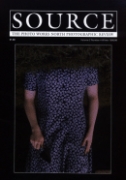Shankill Meets Falls
Shankill meets Falls Community Initiative supported by Cultural Traditions, Community Relations Council, Belfast City Council.
Review by Nicholas Allen
Issue 6 Winter 1995
View Contents ▸
The exhibition Shankill Meets Falls is described as a community initiative with the primary aim of trying, in the words of the organisers, to "dispel the notion that the two cultures within Northern Ireland are widely different". The medium by which to make this connection is photographic and so it is interesting to interpret common signs between the various practices displayed.
The most striking recurrence of shared symbolism between the 'two' communities is that of the prominence of commercial advertising hoardings in the photographs. For example, an Orange march is framed by a poster of a happy beer drinker. In the foreground the faces of the marchers themselves are covered by a billowing banner. The police in attendance are blurred. Conversely, the only actual human face on show holds out a hand palm outwards as if to ward off the evil of recognition. The advert then becomes the only stable symbol in the picture. Similarly a heavily barricaded army tower lurks behind another beer poster which reads "A Long Wait". The reference is at first painfully obvious. But with the natural subversion of an easily bored mind one is forced to come to one of two conclusions. The first is that these photographers have uncovered a previously hidden NIO strategy to promote peace through McCann-Ericson and a hideous poster campaign for the hard-drinking, Northern working classes. Just like the TV adverts we've been blitzed with recently except with an added dulling, alcohol sodden populism.
The second possibility is that, perhaps perversely, the commercial image is what may bind our community more indeed than any growth of human understanding within our region. Perhaps this seems like a depressing possibility. However, other images within the exhibition tend to confirm it. For instance, there are (of course) many more images of marches, both Protestant and Catholic, on display. A memorable picture documents an American style marching band complete with pom-poms and gaudy short cut skirts. Their colour is quite spectacularly repulsive but one is drawn to the logo emblazoned on their chests. It reads "Catholic" in orange (or should I say gold?) - yellow swirls, a distinction so flashily exposed that it could quite gracefully adorn the product of any multinational soft-drink producer. Likewise a group of Protestant marchers follow a collection of flags, one of which is the Stars and Stripes. Beyond this one looks for the traditional black suits of the well heeled following their path to cultural justification. Instead the viewer is treated to a collection of young people, one of whom is wearing a green jacket with the name Cantona emblazoned on its back. The jacket could easily be imagined on the broad shoulders of any sophomore at High School with its college football logo of a bulldog. The point is that even in these supposedly separate cultures, many people are drawn to an imagined community which is not necessarily sectarian or even directly relevant to an experience of living in the North of Ireland. And perhaps here the exhibition does achieve its ambition to show that Northern Ireland's 'two' cultures are not widely different. However before we all congratulate ourselves for discovering a long cherished hope to be a fact, we should perhaps consider another factor. In the first place the totems of previously adhered to cultures are still nursed like a grievance in the imagery of many of the photographs. For example, one can feel the weight of flags allied to utterances such as "Christ Died For The Ungodly" - I was tempted to tag on "So Watch Out" such is the feeling of menace in even this most devotional of platitudes.
However, community photography has in this case begun to formulate a subversive antidote. One is, after all, able to notice connections between the various perceptions and images on display. It is of utmost importance to stress that the exhibition works in spite of the best intentions of its sponsors. One does not leave smiling, incanting "Oh weren't those marches a beautiful sight" or "Wouldn't Belfast be great if we could all have a bit o'crack at Windsor Park one year and Casement Park the next". Instead you come to realise that yes, we still have great problems in our community (and these photographs often capture the economic harshness well). But you also notice that the country is changing due in no small part to the fact that free market advertising and culture accept no boundaries. It may be interesting (if peace holds) to analyse the new battles that will go on for the regional control of new types of culture, identity and their expression.
Other articles by Nicholas Allen:
Issue 4: Reviewing My Insolent Ontologies - The Family Album [Review] ▸
Issue 13: Causality and Contingency - Irish Landscape Images [Review] ▸
Other articles on photography from the 'Political' category ▸






